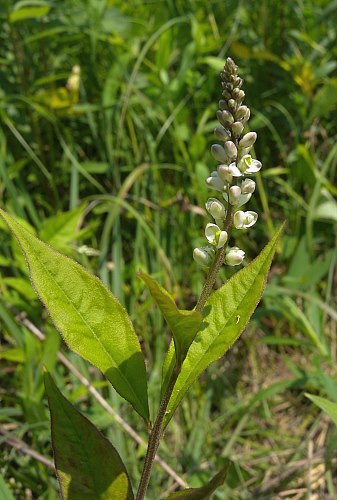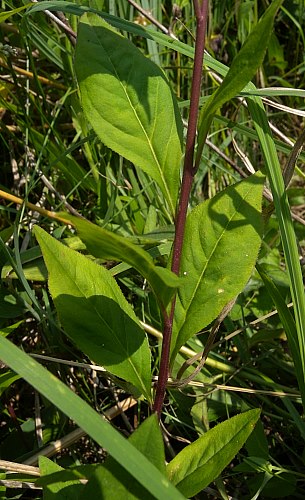Description: This perennial wildflower is 1-1¾' tall, producing one or more leafy stems from the root system that are erect to ascending. These stems are light green to reddish purple, terete, and usually unbranched; they are rough-canescent above and mostly glabrous below. Alternate leaves occur along these stems that are variable in size: toward the bottom of each central stem, the leaf blades are small and scale-like, while along the middle to upper parts of the stem they are 1-2½" long and ¼-¾" across. The middle to upper leaf blades are narrowly lanceolate to ovate and smooth to finely serrated along their margins; the margins are often slightly ciliate. The typical variety of Seneca Snakeroot has narrow leaf blades less than ½" across, while var. latifolia has wider leaf blades that sometimes exceed ½" across. The upper blade surface is yellowish to medium green and glabrous to sparsely canescent, while the lower blade surface is pale green and sparsely canescent. The petioles of the leaves are 1/8" (3 mm.) long or less.

The central stem
(and any lateral stems) terminates in a spike-like raceme of flowers
about 1½-3" long; the small flowers are arranged densely along the
central stalk of the raceme, blooming from the bottom to the top. The
central stalk of the raceme is light green and canescent. Individual
flowers are about 1/8" (3 mm.) across, consisting of 3 white petals, 2
white
petaloid sepals, 3 light green to purple non-petaloid sepals, 8 stamens
that are arranged in 2 rows, and a pistil with a single style. The
petals form a tubular corolla around the reproductive organs of the
flower, while the petaloid sepals form lateral wings. One of the petals
is usually fringed. The inconspicuous pedicels of the flowers are less
than 1/8" (3 mm.) in length. The blooming period occurs from late
spring to
early summer and lasts about 3-4 weeks. The flowers are replaced by
2-celled seed capsules that 2-4 mm. long, 3-4 mm. across, and somewhat
flattened. Each cell of the capsule contains a single lanceoloid seed
about 1/8" long that is slightly hairy toward the bottom. The root
system consists of a slightly woody crown or taproot with secondary
fibrous roots.
Cultivation:
The preference is full or partial sun, dry-mesic conditions, and soil
containing loam, clay-loam, or rocky material.
Range & Habitat:
Seneca Snakeroot is occasional in northern and central Illinois, while
in the southern part of the state it is largely absent (see Distribution
Map). Habitats include upland gravel prairies, hill prairies,
savannas, wooded slopes along rivers or lakes, and abandoned fields.
Occasional wildfires and other kinds of disturbance are beneficial if
they reduce competition from woody vegetation.

Faunal
Associations:
Various small to medium-sized bees visit the flowers for nectar or
pollen. Caterpillars of the moth, Phytometra rhodarialis
(Pink-Border Yellow), feed on Polygala spp.
(Milkworts). Mammalian herbivores probably feed on the foliage only to
a limited extent, if at all, because of its bitterness.
Photographic Location:
The Coneflower Hill Prairie near Lake Shelbyville in Moultrie County,
Illinois. The photographed plant is the wide-leaved variety of Seneca
Snakeroot, Polygala senega latifolia.
Comments:
The flowers of Seneca Snakeroot have a bud-like appearance even when
they are open. For this species, there is some significant variability
in the width of the leaves and the size of the seed capsules and their
seeds. In Illinois, other Polygala spp. (Milkworts)
have non-white flowers or their leaves are whorled, rather than
alternate. They also tend to be smaller in size overall than Seneca
Snakeroot. Therefore, it is fairly easy to distinguish Seneca Snakeroot
from these other species. This species also superficially resembles
some Persicaria spp. (Smartweeds) with white
flowers, however the latter have conspicuous ochreae (sheaths) that
wrap around their stems and they prefer wetter habitats. Seneca
Snakeroot also has floral racemes that superficially resemble those of Orbexilum
pedunculatum (Sampson's Snakeroot), but the latter species
can be easily distinguished by its trifoliate leaves.